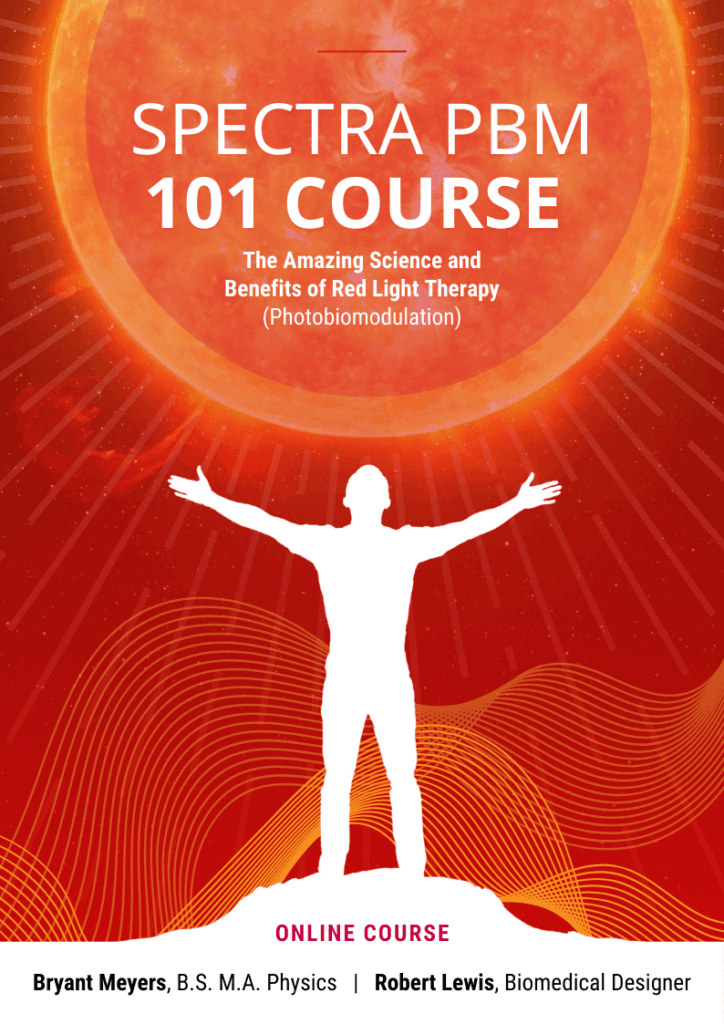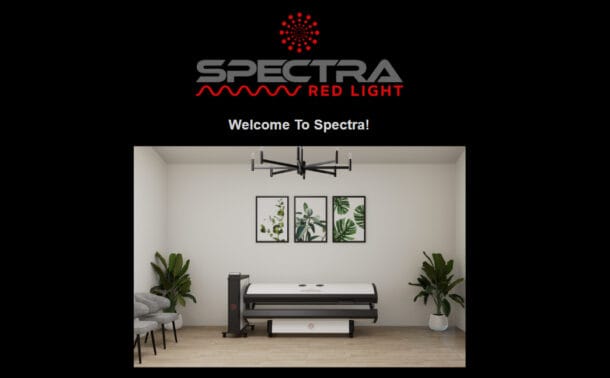According to the World Health Organization, oxidative stress contributes to over 80% of chronic diseases, including cardiovascular, neurodegenerative, and inflammatory conditions.[1] As a result, therapies that modulate oxidative balance and enhance mitochondrial function are gaining global attention in both clinical and wellness settings.
Among the most promising non-invasive strategies are Red Light Therapy (RLT) and Molecular Hydrogen (H₂), two scientifically validated modalities that act on the cellular level to restore physiological homeostasis. Red Light Therapy, also known as photobiomodulation, operates through the absorption of specific wavelengths of light by cytochrome c oxidase (CCO) in the mitochondrial respiratory chain. This photon-induced activation leads to enhanced adenosine triphosphate (ATP) synthesis, improved cellular respiration, and secondary signaling cascades that reduce inflammation, modulate oxidative stress, and accelerate cellular regeneration.
Molecular Hydrogen, delivered via hydrogen-rich water or inhaled gas, complements this process by selectively neutralizing cytotoxic reactive oxygen species (ROS), particularly hydroxyl radicals (•OH), without disrupting beneficial redox signaling. It also activates cytoprotective transcription factors such as Nrf2, while downregulating pro-inflammatory mediators like NF-κB, offering a multi-faceted defense against oxidative damage and chronic inflammation.
When these two modalities are combined, their biological effects appear to synergize, creating an enhanced bioenergetic environment that promotes mitochondrial resilience, redox balance, and cellular repair. This article explores the physiological mechanisms, scientific evidence, and practical applications behind the integration of Red Light Therapy and Molecular Hydrogen, two powerful tools working in harmony to optimize human health
Red Light Therapy: Photobiomodulation at the Mitochondrial Level
Red Light Therapy (RLT), also known as photobiomodulation (PBM), is a scientifically recognized modality that utilizes specific wavelengths of visible red and near-infrared light to modulate biological activity at the cellular level. Its primary target is the mitochondrion, the powerhouse of the cell, where it enhances bioenergetic function and promotes systemic physiological benefits.
At the core of this mechanism is the enzyme cytochrome c oxidase (CCO), a key component of Complex IV in the mitochondrial electron transport chain. When red and near-infrared photons penetrate the tissue and are absorbed by CCO, this stimulates the enzyme’s activity by displacing inhibitory nitric oxide (NO), thereby increasing the efficiency of electron transfer and boosting the production of adenosine triphosphate (ATP), the body’s essential energy currency.
The increase in ATP production leads to:
- Improved cellular metabolism
- Enhanced tissue repair and regeneration
- Better systemic energy availability
- Upregulation of antioxidant enzymes such as superoxide dismutase (SOD) and glutathione peroxidase (GPx)
In addition to its energy-enhancing effects, RLT exerts a hormetic effect, a mild, beneficial biological stress that activates adaptive cellular responses. This includes the temporary production of reactive oxygen species (ROS), which at controlled levels act as signaling molecules that stimulate gene transcription, cell survival pathways, and anti-inflammatory processes.
RLT also facilitates vasodilation by increasing the local availability of nitric oxide, thereby improving microcirculation and nutrient delivery to tissues. This is particularly important for muscle recovery, skin rejuvenation, and organ-level cellular oxygenation.
When used in conjunction with Molecular Hydrogen, Red Light Therapy’s mitochondrial activation is further protected and stabilized. Hydrogen’s role in selectively neutralizing excess ROS ensures that the pro-oxidant activity of photobiomodulation remains beneficial, without tipping into oxidative stress. This balance allows users to experience heightened ATP synthesis and mitochondrial efficiency while shielding the cell from redox imbalance.
In essence, Red Light Therapy sets the stage for cellular renewal and bioenergetic optimization, and when paired with Molecular Hydrogen, the result is a more resilient, high-functioning cellular environment. The synergy between these two modalities opens new avenues for restoring metabolic balance, enhancing recovery, and supporting overall vitality.
Molecular Hydrogen: The Smallest, Smartest Antioxidant
Molecular Hydrogen (H₂) is one of the most promising bioactive agents in modern wellness science, remarkable not only for its simplicity but for its selective and intelligent antioxidant behavior. Composed of two hydrogen atoms, this diatomic molecule is the smallest in the universe, allowing it to rapidly diffuse through cell membranes, organelles, and even the blood-brain barrier with ease. When consumed via hydrogen-rich water or inhaled as gas, it enters the body and begins acting at the deepest levels of cellular physiology.
One of Molecular Hydrogen’s most unique attributes is its ability to selectively neutralize harmful reactive oxygen species (ROS), especially the highly toxic hydroxyl radical (•OH) and peroxynitrite (ONOO⁻). These forms of ROS are among the most damaging to DNA, proteins, and lipid membranes. Unlike conventional antioxidants, hydrogen does not interfere with beneficial ROS, such as hydrogen peroxide (H₂O₂) or nitric oxide (NO), which are essential for cellular signaling and immune function. This means hydrogen supports a balanced redox environment without blunting the adaptive signaling effects that are part of the body’s natural stress responses.
On a molecular level, hydrogen influences several cytoprotective pathways, including:
- Activation of the Nrf2 pathway, which promotes the transcription of endogenous antioxidant enzymes like glutathione, catalase, and superoxide dismutase (SOD).
- Inhibition of NF-κB signaling, a key driver of chronic inflammation and cytokine production.
- Downregulation of pro-apoptotic factors and preservation of mitochondrial membrane potential, protecting cells from premature death and dysfunction.
Molecular Hydrogen also shows promise in mitochondrial protection, reducing oxidative damage while supporting optimal energy metabolism. This is particularly relevant when used in conjunction with Red Light Therapy. While RLT enhances mitochondrial output and beneficial ROS production, hydrogen helps to buffer against excessive oxidative stress, stabilizing cellular function without dampening the signaling mechanisms that drive regeneration.
Hydrogen contributes to cellular hydration, inflammation resolution, and immune modulation, which may explain its positive effects across a wide range of physiological systems, from cardiovascular and metabolic health to skin, brain, and muscle performance.
In the context of combined use, hydrogen acts as a biological safeguard that supports and amplifies the effects of Red Light Therapy. By ensuring that RLT-induced mitochondrial activation occurs in a redox-balanced environment, hydrogen enables the body to experience deeper recovery, more sustained energy, and enhanced protection at the cellular level.
Together, Red Light Therapy and Molecular Hydrogen offer a dual approach to systemic vitality. RLT energizes and regenerates, while hydrogen protects and balances. This synergy provides a powerful foundation for modern wellness strategies aimed at long-term resilience and optimal function.

Synergistic Mechanisms: Why Hydrogen and Red Light Work Better Together
When viewed independently, both Red Light Therapy (RLT) and Molecular Hydrogen (H₂) demonstrate well-documented physiological benefits rooted in mitochondrial activation, oxidative stress modulation, and systemic anti-inflammatory effects. However, when used in combination, these two modalities create a synergistic biological environment that enhances cellular function more powerfully than either therapy alone.
At the core of this synergy lies a shared target: reactive oxygen species (ROS), the molecular byproducts of metabolism that can function as critical signaling molecules or harmful agents depending on concentration and context. As noted in the peer-reviewed study Mechanisms and Mitochondrial Redox Signaling in Photobiomodulation, “it has emerged that many of the mechanistic pathways for mediating the biological effects of PBM do in fact involve ROS.” [2] Photobiomodulation relies on transient ROS generation following photon absorption by cytochrome c oxidase in mitochondria. These temporary increases in ROS are not inherently harmful; instead, they trigger adaptive pathways that lead to mitochondrial biogenesis, gene transcription, and tissue regeneration—a phenomenon known as mitohormesis.
Yet, this process must be tightly regulated. If ROS production exceeds the antioxidant capacity of the cell, it can lead to oxidative damage, cellular dysfunction, and inflammation. This is where Molecular Hydrogen offers a unique, complementary role. According to the study Molecular Hydrogen Therapy—A Review on Clinical Studies and Outcomes, “Given the molecular effects of mitigating the most damaging reactive oxygen species, H₂ should be most effective in treating diseases correlated with high levels of oxidative stress.” [3] Unlike broad-spectrum antioxidants, H₂ specifically targets hydroxyl radicals (•OH) and peroxynitrite (ONOO⁻), the most cytotoxic ROS, while leaving beneficial species like hydrogen peroxide (H₂O₂) intact, preserving essential redox signaling.
This dynamic, RLT generating adaptive ROS, and H₂ buffering excessive ROS, creates a redox environment that is both productive and protected. Hydrogen ensures that the pro-healing and mitochondrial-activating signals of RLT are allowed to occur without tipping into oxidative overload, thereby enhancing the safety, efficacy, and cellular response to photobiomodulation.
Timing is another factor in maximizing synergy. Research from the study Low-level laser (light) therapy increases mitochondrial membrane potential and ATP synthesis in C2C12 myotubes found that “3h to 6h could be the best time-response for light therapy to improve muscle metabolism.” [4] Integrating hydrogen consumption before, during or shortly after Red Light Therapy sessions may help extend the window of mitochondrial activation while mitigating delayed oxidative responses.
Further, hydrogen’s systemic effects on redox-sensitive transcription factors such as Nrf2 and NF-κB complement RLT’s known influence on inflammatory modulation and cellular energy dynamics. As highlighted in the review Potential role of molecular hydrogen therapy on oxidative stress and redox signaling in chronic kidney disease, “Research indicates that H₂ holds promise in treating numerous diseases linked to oxidative stress in CKD,” [5] talking about its therapeutic relevance in conditions characterized by chronic oxidative imbalance.
In addition to its selective antioxidant effects, hydrogen’s molecular size and bioavailability significantly enhance its therapeutic potential. As noted in the study Medical Application of Hydrogen in Hematological Diseases, “the molecules of hydrogen are very small and have a strong penetrating ability, which can quickly penetrate the biofilm and reach a high concentration within the cell for therapeutic effects.” [6] This unique ability allows H₂ to diffuse across cellular membranes, mitochondrial membranes, and even the blood-brain barrier, delivering targeted antioxidant and anti-inflammatory action precisely where it’s needed most.
Recent research into hydrogen as a performance-enhancing molecule continues to build interest in its integrative use. In the study Hydrogen Gas as an Exotic Performance-Enhancing Agent: Challenges and Opportunities, the authors state, “Given the molecular effects of mitigating the most damaging reactive oxygen species, H₂ should be most effective in treating diseases correlated with high levels of oxidative stress.” [7] When combined with Red Light Therapy’s stimulation of mitochondrial metabolism and ATP production, hydrogen serves as an intelligent safeguard, enhancing performance, reducing cellular stress, and optimizing recovery.
In essence, Red Light Therapy activates the engine of the cell, its mitochondria, while Molecular Hydrogen serves as both a guardian and regulator, ensuring that this activation proceeds smoothly, safely, and sustainably. Together, they optimize energy production, accelerate recovery, modulate inflammation, and preserve long-term cellular health, offering a powerful, dual-acting strategy for comprehensive bioenergetic wellness.

Applications and Targeted Use Cases: Red Light Therapy and Molecular Hydrogen
The combination of Red Light Therapy and Molecular Hydrogen (H₂) presents a cutting-edge wellness strategy that can be applied across a wide range of physiological needs. Whether the goal is to enhance physical performance, accelerate recovery, support cognitive function, or reduce chronic inflammation, this duo offers a powerful, non-invasive solution grounded in science. Below are some of the most promising use cases where the synergistic effects of RLT and hydrogen can provide measurable results.
Athletic Performance and Recovery
Athletes and active individuals place high metabolic demands on their bodies, often resulting in oxidative stress, muscle fatigue, and delayed recovery. Red Light Therapy enhances mitochondrial respiration, leading to increased ATP production, improved muscle oxygenation, and reduced muscle soreness. Meanwhile, Molecular Hydrogen counters excessive exercise-induced ROS, minimizing oxidative damage to muscle fibers and reducing inflammatory markers such as interleukin-6 (IL-6) and tumor necrosis factor-alpha (TNF-α).
Combined benefit: Accelerated muscle recovery, reduced inflammation, and enhanced endurance through mitochondrial optimization and oxidative balance.
Neurological Support and Cognitive Resilience
Both Red Light Therapy and hydrogen show neuroprotective effects, especially in conditions associated with cognitive decline, brain fog, or neuroinflammation. RLT improves cerebral blood flow, stimulates brain-derived neurotrophic factor (BDNF), and supports neuronal mitochondrial health. Hydrogen, due to its ability to cross the blood-brain barrier, reduces neuroinflammatory cytokines, prevents lipid peroxidation in neuronal membranes, and modulates signaling pathways like PI3K/Akt involved in cell survival.
Combined benefit: Enhanced mental clarity, memory, and focus, with potential long-term protection against neurodegeneration and inflammation-induced cognitive dysfunction.
Skin Health and Anti-Aging
Aging skin is characterized by oxidative damage, mitochondrial decline, reduced collagen synthesis, and chronic low-grade inflammation. Red Light Therapy stimulates fibroblast proliferation, collagen, and elastin production, and enhances microcirculation in the dermis. Simultaneously, hydrogen neutralizes free radicals that accelerate skin aging and modulates matrix metalloproteinases (MMPs), which are responsible for collagen breakdown.
Combined benefit: Visibly improved skin tone, texture, and elasticity, with reduced fine lines and better protection against environmental oxidative stress.
Immune and Inflammatory Conditions
Many modern health challenges, from autoimmune conditions to chronic fatigue and metabolic disorders, are driven by unchecked inflammation and immune dysregulation. RLT helps downregulate the NF-κB inflammatory pathway, increases regulatory T-cell (Treg) activity, and improves tissue oxygenation. Hydrogen reinforces these effects by reducing pro-inflammatory mediators like C-reactive protein (CRP) and promoting immune homeostasis without suppressing essential immune function.
Combined benefit: Balanced immune response, reduced systemic inflammation, and improved overall resilience in individuals with chronic inflammatory states.
Cardiovascular and Metabolic Support
Both Red Light Therapy and hydrogen influence metabolic and vascular health at the cellular level. RLT stimulates endothelial nitric oxide synthase (eNOS), promoting vasodilation and improving circulation. It also supports metabolic efficiency by improving mitochondrial function in metabolically active tissues. Hydrogen reduces oxidative stress in the vascular endothelium, enhances insulin sensitivity, and reduces lipid peroxidation, all of which are critical in managing metabolic syndrome and cardiovascular risk.
Combined benefit: Improved circulation, metabolic balance, and cardiovascular protection through complementary effects on vascular and mitochondrial function.
Together, Red Light Therapy and Molecular Hydrogen form a robust, science-backed approach to promoting vitality and longevity. Their combined use is ideal for integrative wellness protocols in clinics, fitness centers, and personal wellness routines, helping users not just to feel better, but to function better at the cellular level.

The combination of Red Light Therapy and Molecular Hydrogen represents a scientifically grounded and biologically synergistic approach to enhancing human health at its foundation, the cell. Each modality operates through distinct but complementary mechanisms of action: Red Light Therapy stimulates mitochondrial bioenergetics by enhancing cytochrome c oxidase activity, leading to increased ATP synthesis, improved tissue oxygenation, and modulation of inflammatory signaling pathways. In parallel, Molecular Hydrogen acts as a selective antioxidant, neutralizing cytotoxic free radicals such as hydroxyl radicals (•OH) and peroxynitrite (ONOO⁻) while preserving critical redox signaling needed for cellular adaptation and repair.
This dual approach not only amplifies individual cellular functions but also creates a balanced physiological environment where oxidative stress is mitigated, inflammation is regulated, and mitochondrial performance is optimized. When integrated into a wellness routine, the combined use of RLT and hydrogen supports energy metabolism, cognitive clarity, tissue regeneration, and immune equilibrium, key pillars of long-term resilience and vitality.
For wellness professionals, biohackers, and health-conscious individuals alike, this fusion offers an advanced, non-invasive strategy to restore cellular function, accelerate recovery, and promote systemic well-being. As scientific understanding continues to evolve, the integration of photobiomodulation and molecular hydrogen may well become a cornerstone of forward-thinking wellness protocols, empowering the body to thrive from the inside out.
References
[1] Sies H, Jones DP. Reactive oxygen species (ROS) as pleiotropic physiological signalling agents. Nat Rev Mol Cell Biol. 2020;21(7):363-383. doi:10.1038/s41580-020-0230-3
[2] Hamblin MR. Mechanisms and Mitochondrial Redox Signaling in Photobiomodulation. Photochem Photobiol. 2018 Mar;94(2):199-212. doi: 10.1111/php.12864. Epub 2018 Jan 19. PMID: 29164625; PMCID: PMC5844808.
[3] Johnsen HM, Hiorth M, Klaveness J. Molecular Hydrogen Therapy-A Review on Clinical Studies and Outcomes. Molecules. 2023 Nov 26;28(23):7785. doi: 10.3390/molecules28237785. PMID: 38067515; PMCID: PMC10707987.
[4] Ferraresi C, Kaippert B, Avci P, Huang YY, de Sousa MV, Bagnato VS, Parizotto NA, Hamblin MR. Low-level laser (light) therapy increases mitochondrial membrane potential and ATP synthesis in C2C12 myotubes with a peak response at 3-6 h. Photochem Photobiol. 2015 Mar-Apr;91(2):411-6. doi: 10.1111/php.12397. Epub 2014 Dec 30. PMID: 25443662; PMCID: PMC4355185.
[5] Cai-Mei Zheng, Yi-Chou Hou, Min-Tser Liao, Kuo-Wang Tsai, Wan-Chung Hu, Chien-Chih Yeh, Kuo-Cheng Lu,
Potential role of molecular hydrogen therapy on oxidative stress and redox signaling in chronic kidney disease,
Biomedicine & Pharmacotherapy, Volume 176, 2024, 116802, ISSN 0753-3322, https://doi.org/10.1016/j.biopha.2024.116802.
[6] Qian L, Wu Z, Cen J, Pasca S, Tomuleasa C. Medical Application of Hydrogen in Hematological Diseases. Oxid Med Cell Longev. 2019 Nov 28;2019:3917393. doi: 10.1155/2019/3917393. PMID: 31871547; PMCID: PMC6906850.
[7] Sergej M. Ostojic, Hydrogen Gas as an Exotic Performance-Enhancing Agent: Challenges and Opportunities, Current Pharmaceutical Design; Volume 27, Issue 5, Year 2021, .
DOI: 10.2174/1381612826666200922155242


